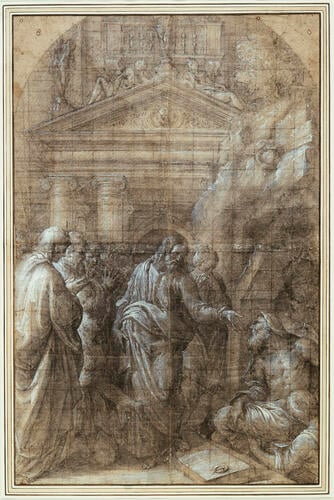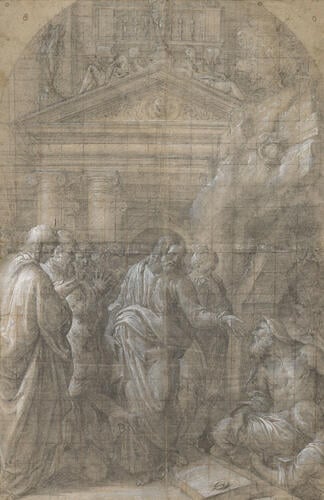-
1 of 253523 objects
The Raising of Lazarus c. 1547
Black chalk with white heightening, on rough pale brown paper; partly squared | 81.5 x 52.5 cm (sheet of paper) | RCIN 991118

Giulio Campi (1502-72)
The Raising of Lazarus c. 1547


-
Giulio Campi designed and decorated the whole of the small church of Santa Margherita in Cremona, for its titular prior, the humanist scholar Marco Girolamo Vida. This is a final study for the Raising of Lazarus, one of six arched frescoes in the side walls of the barrel-vaulted church. The scene is set against an imposing architectural backdrop reminiscent of Campi’s own architectural works.
Giulio Campi worked on several occasions for the humanist scholar Marco Girolamo Vida. His most significant project was the reconstruction and decoration of the small church of Santa Margherita in Cremona, of which Vida was titular prior (see G. Bora, 'La decorazione cinquecentesca nella chiesa della Sante Margherita e Pelagia: il committente e l'artista', in La chiesa delle Sante Margherita e Pelagia. Storia e restauro, P. Bonometti and G. Colalucci eds., Cremona 2008). The completion of this new church in 1547 is recorded in an inscription on the façade. With his brother Antonio, Giulio frescoed the entire interior; the scenes occupying the six side-chapels - in fact little more than arched recesses in the walls of the barrel-vaulted church. On the right are the Presentation in the Temple, the Dispute in the Temple and the Preaching of Jesus; and on the left, the Entry into Jerusalem, the Raising of Lazarus (for which this large drawing is a final study) and the Transfiguration and healing of the possessed child (for which there is an equally large study in the Royal Collection, RCIN 991119). The smaller frescoes in the vault illustrate Old Testament scenes that prefigure the life of Christ below.
The Raising of Lazarus is set against a heavy architectural backdrop of a pediment supported by twinned ionic columns and crowned with sculpture; the effect is strongly reminiscent of Campi’s own architectural works, such as the monumental frame to his altarpiece of St Michael in the Duomo of Cremona. Campi’s classicising tendencies during the 1540s are evident in the rich, broad colouring of the paintings and the symmetry of the compositions. The former can be attributed to the example of Pordenone, who had executed frescoes in the Duomo in the early 1520s, but the latter owes more to Raphael and his followers in Rome. Campi would have been aware of many of Raphael’s compositions through prints, and he may have visited Rome a few years before beginning work in Santa Margherita. The figures of Christ and Lazarus (both reversed), and the Ionic portico in the background may have derived from motifs in Baldassare Peruzzi’s fresco of the Presentation in the Temple in Santa Maria della Pace, Rome.
See M. Clayton, The Art of Italy in the Royal Collection: Renaissance and Baroque, London 2007. In the British Museum is a study for the damaged Adoration of the Shepherds (1941,1108.14; see I segni dell' arte, Il Cinquecento da Praga a Cremona, exhib. cat., Cremona, Museo Civico, 1997, pp. 248-9, reproduced). Another such study was most recently at Sotheby's, New York, 26 Jan 2022, lot 13.Provenance
Presumably in the Royal Collection by c.1810
-
Creator(s)
-
Medium and techniques
Black chalk with white heightening, on rough pale brown paper; partly squared
Measurements
81.5 x 52.5 cm (sheet of paper)
Other number(s)
RL O : Royal Library "O" Number Register – RL O1118